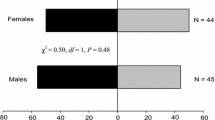Abstract
Behavioral responses of Frankliniella occidentalis Pergande (Thysanoptera: Thripidae) to visual and olfactory cues were assessed in a cylindrical black box and a Y-tube olfactometer. Frankliniella occidentalis preferred circular shapes to other five geometrical patterns (rectangle, triangle, inverted triangle, diamond, and modified circle imitating flower petals) in multiple choice tests. In pair wise choice tests, the thrips preferred the yellow artificial flower shape to the geometrical patterns tested. Frankliniella occidentalis stayed on the artificial flower about four times longer than on the geometrical patterns. Higher numbers of thrips responded to a combination of p-anisaldehyde and artificial flower compared to the arm with only the olfactory or the visual cue. These results suggest that shape is an important cue for F. occidentalis.






Similar content being viewed by others
References
Childers CC (1997) Feeding and oviposition injuries to plants. In: Lewis T (ed) Thrips as crop pests. CAB International, Oxon, pp 505–537
Childers CC, Brecht JK (1996) Colored sticky traps for monitoring Frankliniella bispinosa (Morgan) (Thysanoptera: Thripidae) during flowering cycles in citrus. J Econ Entomol 89:1240–1249
Cho K, Eckel CS, Walgenbach JF, Kennedy GG (1995) Comparison of colored sticky traps for monitoring thrips populations (Thysanoptera: Thripidae) in staked tomato fields. J Entomol Sci 30:176–190
Chu CC, Chen TY, Natwick ET, Fitzgerald G, Tuck S, Alexander P, Henneberry TJ (2005) Light response by Frankliniella occidentalis to white fluorescent light filtered through color films and ultraviolet- and blue light-emmiting diodes. Southwest Entomol 30:149–154
Colazza S, Cristiana Rosi M, Clemente A (1997) Response of egg parasitoid Telenomus busseolae to sex pheromone of Sesamia nonagrioides. J Chem Ecol 23:2437–2444
Davidson MM, Butler RC, Tuelon DAJ (2006) Starvation period and age affect the response of female Frankliniella occidentalis (Thysanoptera: Thripidae) to odor and visual cues. J Insect Physiol 52:729–736
Davidson MM, Butler RC, Winkler S, Tuelon DAJ (2007) Pyridine compounds increase trap capture of Frankliniella occidentalis (Pergande) in a covered crop. NZ Plant Prot 60:56–60
de Jager CM, Butot RPT, Klinkhamer PGL, de Jong TJ, Wolff K, van der Meijden E (1995) Genetic variation in chrysanthemum for resistance to Frankliniella occidentalis. Entomol Exp Appl 77:277–287
de Kogel WJ, and Koschier EH (2003) Thrips responses to plant odours. In: Marullo R, and Mound L (eds) Proceedings of the 7th International Symposium on Thysanoptera, pp 189–190
Frey JE, Cortada RV, Helbling H (1994) The potential of flower odours for use in population monitoring of western flower thrips, Frankliniella occidentalis (Perg.) (Thysanoptera: Thripidae). Biocontrol Sci Technol 4:177–186
Glover B (2007) Understanding flowers & flowering. Oxford University Press, NY, pp 181–191
Hata TY, Hara AH, Hansen JD (1991) Feeding preference of melon thrips on orchids in Hawaii. HortScience 26:1294–1295
Kawai A, Kitamura C (1987) Studies on population ecology of Thrips palmi Karny. 15. Evaluation of effectiveness of control methods using a simulation model. Appl Entomol Zool 22:292–302
Kirk WDJ (1997) Feeding. In: Lewis T (ed) Thrips as crop pests. CAB International, Oxon, pp 119–174
Koschier EH, de Kogel WJ, Visser JH (2000) Assessing the attractiveness of volatile plant compounds to western flower thrips (Frankliniella occidentalis (Pergande). J Chem Ecol 26:2643–2655
Lim UT, Mainali BP (2009) Optimum density of chrysanthemum flower model traps to reduce infestations of Frankliniella intonsa (Thysanoptera: Thripidae) on greenhouse strawberry. Crop Prot 28:1098–1100
Mainali BP, Lim UT (2008) Evaluation of chrysanthemum flower model trap to attract two Frankliniella thrips (Thysanoptera: Thripidae). J Asia Pac Entomol 11:171–174
Mainali BP, Lim UT (2010) Circular yellow sticky trap with black background enhances attraction of Frankliniella occidentalis (Pergande) (Thysanoptera: Thripidae). Appl Entomol Zool 45:207–213
Moreno DS, Gregory WA, Tanigoshi LK (1984) Flight response of Aphytis melinus (Hymenoptera: Aphelinidae) and Scirtothrips citri (Thysanoptera: Thripidae) to trap color, size, and shape. Environ Entomol 13:935–940
Morse JC, Hoddle MS (2006) Invasion of biology of the thrips. Annu Rev Entomol 51:67–89
Muirhead-Thomson RC (1991) Plant pest responses to visual and olfactory ‘sticky’ traps. In: Trap responses of flying insects. Academic, CA, pp 180–196
Parrella MP, O’Donnel C, Murphy BC, Casey C (2003) Thrips. In: Roberts A, Debener T, Guidin S (eds) Encyclopedia of rose science. Elsevier, Amsterdam, pp 437–443
Pizzol J, Nammour D, Hervouet JP, Bout A, Desneux N, Mailleret L (2010) Comparison of two methods of monitoring thrips populations in a greenhouse rose crop. J Pest Sci 83:191–196
Seo MJ, Kim SJ, Kang EJ, Kang KM, Yu YM, Nam MH, Jeong SG, Youn YN (2006) Attraction of the garden thrips, Frankliniella intonsa (Thysanoptera: Thripidae) to colored sticky cards in a Nonsan strawberry greenhouse. Kor J Appl Entomol 45:37–43
Terry I (1997) Host selection communication and reproductive behaviour. In: Lewis T (ed) Thrips as crop pests. CAB International, Oxon, pp 65–118
Teulon DAJ, Penman DR, Ramakers PMJ (1993) Volatile chemical for thrips (Thysanoptera: Thripidae) host-finding and applications for thrips pest management. J Econ Entomol 86:1405–1415
Teulon DAJ, Hollister B, Butler RC, Cameron EA (1999) Colour and odour responses of flying western flower thrips: wind tunnel and greenhouse experiments. Entomol Exp Appl 93:9–19
Vernon RS, Gillespie DR (1990) Spectral responsiveness of Frankliniella occidentalis (Thysanoptera: Thripidae) determined by trap catches in greenhouses. Environ Entomol 19:1229–1241
Vernon RS, Gillespie DR (1995) Influence of trap shape, size, and background color on captures of Frankliniella occidentalis (Thysanoptera: Thripidae) in a cucumber greenhouse. J Econ Entomol 88:288–293
Acknowledgements
This work was supported by the Korea Research Foundation Grant funded by the Korean Government (MOEHRD) (KRF-2007-331-F00010). Bishwo Mainali was supported by the 2nd Stage BK21 program of Ministry of Education, Science, and Technology, Korea.
Author information
Authors and Affiliations
Corresponding author
Rights and permissions
About this article
Cite this article
Mainali, B.P., Lim, U.T. Behavioral Response of Western Flower Thrips to Visual and Olfactory Cues. J Insect Behav 24, 436–446 (2011). https://doi.org/10.1007/s10905-011-9267-7
Revised:
Accepted:
Published:
Issue Date:
DOI: https://doi.org/10.1007/s10905-011-9267-7




